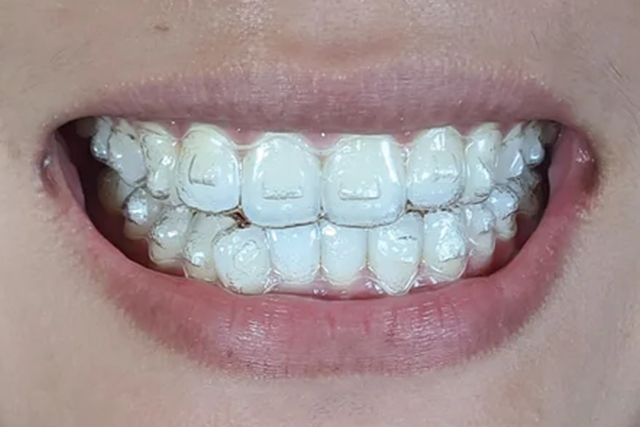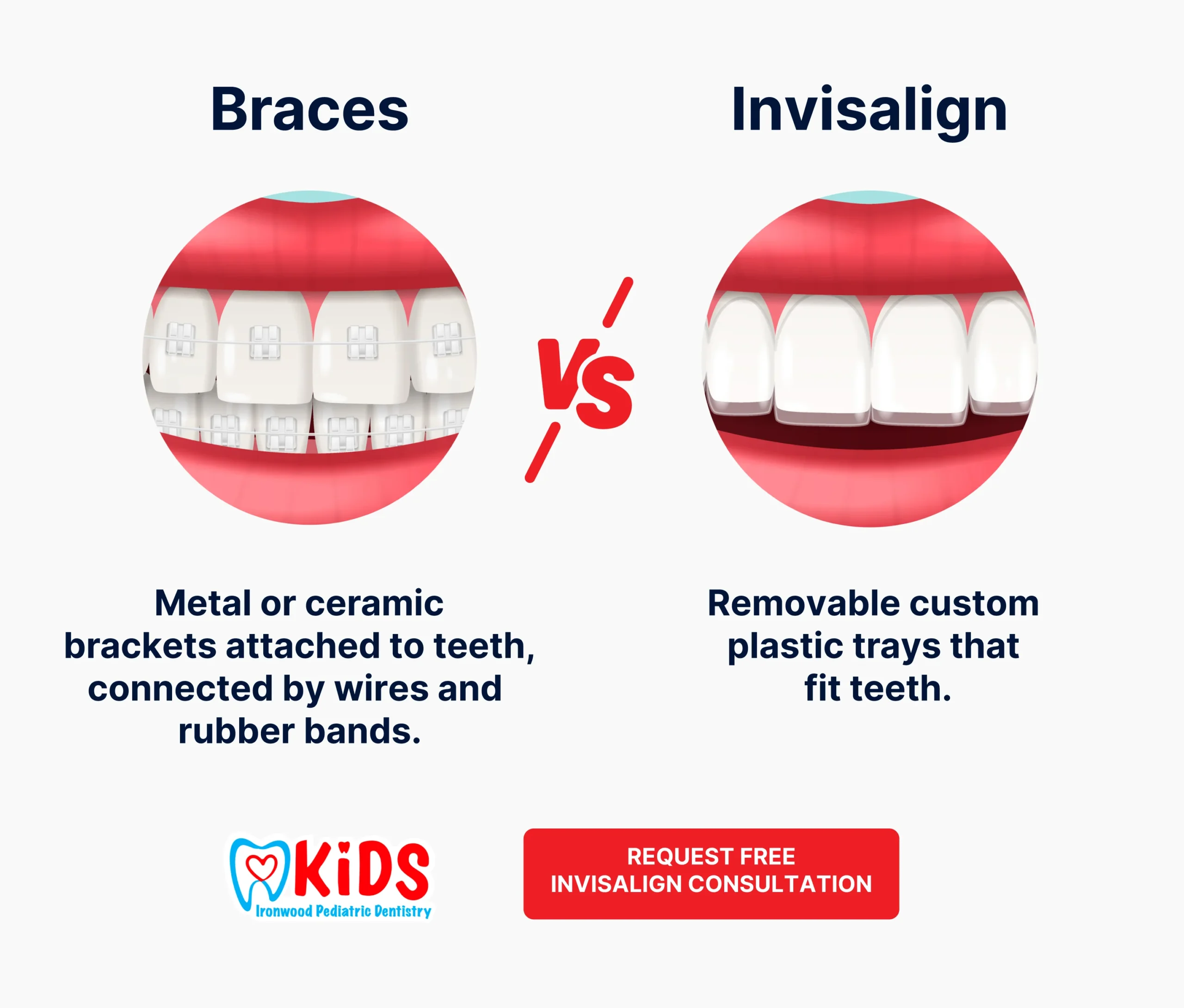Invisalign vs. Standard Braces: Which Alternative Is Right for You?
When thinking about orthodontic treatment, the option in between Invisalign and typical dental braces offers a number of vital aspects that warrant careful examination. Invisalign supplies a discreet alternative with removable aligners, while standard dental braces offer a much more visible yet effective remedy for extreme misalignment. Each option includes distinct advantages and downsides associated with visual appeals, comfort, treatment period, and expense. Understanding these subtleties is crucial for making a notified decision that aligns with your individual choices and way of life. The concern continues to be: which choice will ideal fulfill your orthodontic needs and assumptions?
Review of Therapy Alternatives

On the other hand, conventional dental braces include steel braces and wires that are bonded to the teeth. This technique applies continuous stress gradually to accomplish placement. While reliable for complex orthodontic concerns, typical braces call for normal gos to for modifications and can posture obstacles in preserving dental hygiene as a result of the problem of cleansing around cables and brackets.
Both options have their advantages, and the choice commonly hinges on specific oral problems, lifestyle choices, and person compliance. Eventually, getting in touch with an orthodontic professional is vital for identifying one of the most appropriate treatment strategy customized to individual needs. Comprehending the nuances of each choice can substantially influence the overall success of orthodontic therapy.
Aesthetic Considerations
A considerable variable affecting the selection in between Invisalign and traditional dental braces is the visual allure each therapy supplies. Invisalign aligners are crafted from clear plastic, making them basically unseen when worn.
On the other hand, conventional braces contain steel brackets and cables, which can be a lot more recognizable. While advancements in orthodontic technology have led to the growth of smaller sized brackets and colored elastics, traditional dental braces still maintain a more obvious profile. For some individuals, the visibility of braces may discourage them from seeking essential therapy.
Inevitably, the choice between Invisalign and standard braces might hinge on individual preferences regarding looks. Clients who focus on discretion typically lean toward Invisalign, while those who are less concerned concerning visibility may choose standard braces. Comprehending the aesthetic effects of each choice is important for making a notified choice that lines up with one's way of living and choices.
Comfort and Convenience

In regards to convenience, Invisalign aligners are detachable, making it possible for individuals to appreciate their favored foods without constraint and keep optimal oral hygiene. Brushing and flossing are simplified, as the aligners can be gotten throughout these routines, whereas traditional braces call for cautious maneuvering around cords and braces.
Additionally, Invisalign's modern system permits fewer orthodontic gos to. People normally get several collections of aligners simultaneously, which can improve the therapy process and reduce time invested in the orthodontist's chair. In contrast, standard braces necessitate routine adjustments, making them less convenient for those with busy schedules. Invisalign. Overall, the convenience and benefit of Invisalign make it an enticing choice for lots of people looking for orthodontic therapy.
Therapy Period and Efficiency
While both Invisalign and typical dental braces are reliable in dealing with dental imbalances, the period of therapy can differ substantially in between the two options. Usually, Invisalign treatment can take anywhere from 12 to 18 months, relying on the complexity of the situation. The clear aligners function by slowly changing teeth right into their desired settings, and routine follow-ups with an orthodontist aid make certain progression continues to be on the right track.
In contrast, typical braces typically need a longer dedication, generally ranging from 18 months to 3 years. This results from their set nature and making use of cables and braces, which can be more efficient for complex instances and extreme misalignments (Invisalign). The treatment performance of typical dental braces is well-documented, as they permit specific changes and higher control over tooth activity
Inevitably, the selection between Invisalign and traditional braces may depend upon both the awaited treatment period and the certain oral problems handy. Consulting with an orthodontist is important, as they can give tailored recommendations based on private demands, ensuring the selected approach aligns with desired results click to find out more and timeframes.
Price Comparison and Insurance Coverage Choices
Expense plays a considerable duty in the decision-making process for individuals considering orthodontic treatment, whether choosing Invisalign or typical dental braces. Typically, the cost of Invisalign varieties from $3,000 to $8,000, while standard braces normally cost in between $2,000 and $6,000. Aspects affecting these costs include the intricacy of the instance, the duration of treatment, and geographical location.
Insurance policy protection can substantially influence out-of-pocket expenditures. Many dental insurance policy strategies provide partial protection for orthodontic therapies, yet the specifics can vary widely. It is crucial for individuals to assess their insurance coverage to determine the level of insurance coverage for either alternative. Normally, conventional dental braces may be a lot more frequently covered by insurance coverage strategies compared to Invisalign, go to the website which some insurance firms categorize as a cosmetic treatment.
Additionally, a number of orthodontic practices offer flexible payment plans, making both treatment choices much more available. Patients should ask about potential funding options and discounts for in advance settlements. Reviewing the overall expense, including insurance coverage advantages and layaway plan, is crucial for making an informed decision that straightens with both visual choices and spending plan considerations.

Conclusion
In recap, the selection between Invisalign and conventional dental braces depends upon several variables, consisting of aesthetic preferences, comfort, treatment duration, and price. Invisalign provides a very discreet, detachable alternative that facilitates dental hygiene and nutritional adaptability, while conventional dental braces might be extra ideal for complicated dental issues and often come at a lower rate factor. Eventually, assessment with an orthodontist is vital to evaluate private conditions and figure out one of the most appropriate therapy choice for achieving ideal oral alignment.
When thinking about orthodontic try this website treatment, the option between Invisalign and traditional dental braces presents several crucial variables that warrant cautious analysis.Comparing Invisalign and standard dental braces discloses distinct therapy choices for orthodontic correction.While both Invisalign and standard dental braces are efficient in dealing with dental imbalances, the duration of treatment can differ significantly in between the 2 choices.Expense plays a significant role in the decision-making process for individuals considering orthodontic therapy, whether opting for Invisalign or conventional dental braces.In recap, the selection between Invisalign and traditional dental braces hinges on numerous aspects, consisting of visual choices, comfort, therapy duration, and expense.
Comments on “Success Stories: How Invisalign Changed Lives and Improved Confidence”